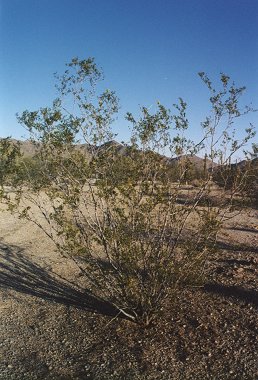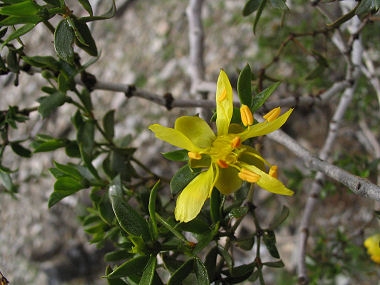The Creosote Bush is a member of the
caltrop family. It is an evergreen shrub which grows
 to
10 feet in height, and has many branched woody stems that grow from the
ground. Creosote Bush typically grows below 4500 feet in elevation and
prefers dry plains and mesas. The plant is a common and wide spread
shrub in three of the four North American deserts (the Mohave, Sonoran
and Chihuahuan Deserts, it is too cold for the plant to grow in the
Great Basin Desert). Leaves are small, dark green and oblong to 3/8
inches long, with two leaflets joined at the base. The plant can bloom
at several times during the year, but flowers are most common between
March - April and November - December. Flowers are yellow with 5 petals
to 1 inch in diameter and are followed by a small, round, fuzzy, white
fruit about 1/4 inch in diameter. to
10 feet in height, and has many branched woody stems that grow from the
ground. Creosote Bush typically grows below 4500 feet in elevation and
prefers dry plains and mesas. The plant is a common and wide spread
shrub in three of the four North American deserts (the Mohave, Sonoran
and Chihuahuan Deserts, it is too cold for the plant to grow in the
Great Basin Desert). Leaves are small, dark green and oblong to 3/8
inches long, with two leaflets joined at the base. The plant can bloom
at several times during the year, but flowers are most common between
March - April and November - December. Flowers are yellow with 5 petals
to 1 inch in diameter and are followed by a small, round, fuzzy, white
fruit about 1/4 inch in diameter.
|
Creosote Bush gets its name from
the odor the leaves emit after a rain (or when crushed), though
creosote is a petroleum product and unrelated to the bush. |
The Creosote Bush is the most drought tolerant plant
in North America. It can live for at least 2 years without any rain
whatsoever, and will lose its leaves and even shed branches to reserve
the last water and nutrients for the crown. The roots of the creosote
bush have been shown to inhibit the growth of bursage roots and the
roots of other creosote bushes (which is why the plants often grow at
evenly spaced intervals in the desert). The plant does not inhibit the
growth of other species though, and often acts as a nurse plant for
other plants and cacti which are able to survive in the little shade the
bush provides. The only mammal that eats creosote bush leaves is the
jackrabbit, which turns to them as a last resort when nothing else is
available. Other animals, such as rodents and reptiles will dig their
burrows in the soil beneath the shrubs. Creosote Bushes live a very long
time. Though each stem of the plant may live to be several centuries
old, new ones are continually produced from the outer edge of the root
crown, eventually forming a ring. There is a creosote bush ring in the
Mohave Desert in California that is several thousand years old. Native
Americans brew a medicinal tea from the plant.

|

